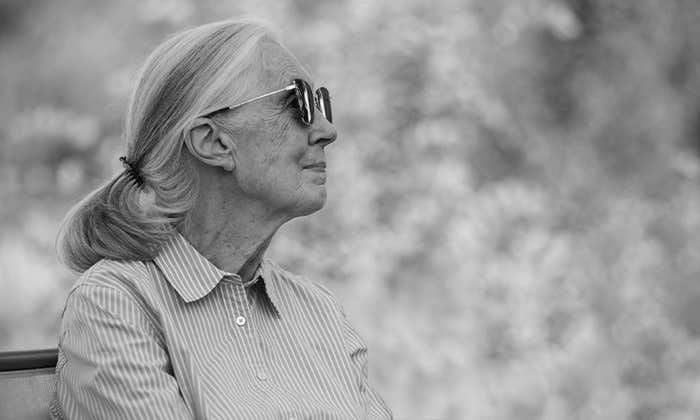In 1938, Gwendolen Howard purchased a plot of land at the edge of Ditchling, a town near Brighton, England. Howard played the viola in a London orchestra, but, now in her mid-40s, had grown tired of city life. She also wanted to study birds.
When she moved into Bird Cottage, as Howard named the house she built in Ditchling, she didn’t yet know birds very well. She did, however, have misgivings about how birds were being studied by scientists. Many birds, then as now, were kept in captive conditions that greatly influenced their behavior. Birds in small cages could not fly; they were often kept alone, despite being social creatures. They were also afraid of the scientists studying them. Howard believed that all of these factors warped their behaviors and our understanding of them.
Howard took a different approach. She opened the windows of her cottage, so that her avian neighbors could come and go as they pleased. She fed them, but she did not capture, domesticate, or tame them. Nearby birds—blue tits and great tits, robins, sparrows, blackbirds—soon came to trust her.
She would go on to collect some of the most unique observations ever made of birds, and set an example that remains relevant today.
On a spring morning three months after she moved in, when Howard was busy in the house, a blue titmouse—Cyanistes caeruleus, part of a family that includes chickadees—flew up to her in what Howard perceived as obvious distress. The bird hovered closely in front of her face, cried out, and fixed her eyes on Howard’s. The bird’s partner was just outside, also trying to get Howard’s attention. She followed them into the garden and saw that their nest had been pulled out of the entrance hole of their nesting box, probably by a cat. Howard picked up the pieces and put the nesting materials and eggs back into the box.
“It was obvious something was wrong and she was asking for my help,” Howard later wrote. This incident changed how Howard saw birds. She would go on to collect some of the most unique observations ever made of birds, and set an example that remains relevant today.
At that time, scientists saw birds as creatures governed primarily by instinct. The field of ethology—the study of animal behavior—was then in its infancy, with pioneering scientists including Konrad Lorenz and Nikolaas Tinbergen bringing experimental rigor to what had been a largely anecdotal field. However, they focused primarily on the role of instinct, rather than on richer forms of intelligence. Although Howard was critical of scientific methods, she had not objected to the understandings they produced. She did not expect the songbirds who lived nearby to be very intelligent at all.
The incident with the blue titmice showed her that birds do not act solely on instinct—which ostensibly would tell them to be wary of humans, not seek one out when threatened—but could think flexibly. “What else except thought could have made her act thus?” she asked.
That interpretation would not pass scientific muster. It is anecdotal. One can easily imagine alternative explanations. The observations were not verified or replicated. But anecdote is still important in expanding the realm of possibility, in providing the raw material of further understanding—and Howard was uniquely positioned to gather it.
After the incident with the blue tits, Howard decided to not just study bird song, but to also write about their characters, relationships, and inner lives. Some birds came to her for food; others preferred the insects and berries they found themselves but still sought out her company. The birds sat on her hands as she typed or played the piano; in the morning, fledglings skied on her pillow and played with her hair. There were birds who slept in the cardboard boxes she attached to her walls and ceilings, birds who preferred to sleep outside in nesting boxes, shrubs or trees, and birds who found their own sleeping places in the house.
Through living in close proximity with these birds, Howard witnessed aspects of their lives that usually remain hidden. She learned to read their facial expressions, feather postures, and the meaning of their calls and songs. Howard took careful notes on their behaviors and characters, chronicling their stories and relationships—with one another and with her—in detail.
The birds sat on her hands as she typed or played the piano; in the morning, fledglings skied on her pillow and played with her hair.
A blackbird whom Howard named Oakleaf, for example, would engage in territorial battles “with his oak leaf, held like a talisman, in his bill.” Other types of leaves were available, but he only used oak. One of Howard’s closest companions was Star, a great tit whom she taught to count: Howard rapped a number of times on a window sill or table, and Star responded by tapping the same number with her beak on the wood. Another notable relationship involved Baldhead, a fierce and bright male great tit, who did not shy from fights with other birds but was also very interested in fledglings. With Monocle, his final partner, Baldhead adopted eight fledglings whose parents had died.
Another account, in which Baldhead also features, speaks to the biographical depth of Howard’s observations. Before Monocle, Baldhead was partner to both Jane and Grey, tending to each while they built nests and sat on their eggs. After the chicks hatched, though, Baldhead only helped Jane with their feeding. Grey kept calling to him, but he ignored her. After a few days of distress, she stopped eating and soon died—perhaps, surmised Howard, of a broken heart. As for Jane, she was exceptionally musical. Though female great tits are not known for their singing, her unique nesting-season songs were much more melodious than the local males’ songs.
Howard published her accounts in natural history periodicals, writing under the pen name of Len Howard. She left no record of why she chose this name, but—then as now—the intellectual works of men were taken more seriously than those of women. In 1952, Howard released her first book, Birds as Individuals.
Julian Huxley, an eminent biologist of the time, wrote the foreword. He acknowledged the value of Howard’s observations and her critique of the distorting influence of fear on bird behavior, though perhaps felt some reservations. “Miss Howard will not expect professional biologists to accept all her conclusions,” Huxley wrote. “But they will be grateful for her facts.”
Howard’s observations were also lauded by Tinbergen, who would later win a Nobel Prize for his research on animal behavior. “Miss Howard describes most amazing things, and critical zoologists and psychologists, if not familiar with the ways of birds in the wild, may tend to armchair incredulity,” wrote Tinbergen in the journal Ibis. “I have no such doubts, however.”
Birds as Individuals was followed in 1956 by Living With Birds, which like its predecessor was moderately successful. Howard’s work would gradually be forgotten, though, and remains little-known now. Her personal approach, lack of formal training, use of a non-scientific vocabulary, and perhaps her gender, too, all contributed to the fact that she was not appreciated as much as her male colleagues at the time. Perhaps her insights were simply too radical.
She learned to read their facial expressions, feather postures, and the meaning of their calls and songs.
If Howard’s reliance on anecdotes opened her to criticism, though, together they demonstrated her larger point. “A profoundly significant generalization emerges through the anecdotal method of reporting biographies or biographical vignettes,” wrote Eileen Crist, a sociologist and environmental scholar, in a 2006 essay on Howard. “There exists tremendous diversity of behavior among birds, both consequence and expression of their individuality.”
Nowadays many of Howard’s views about bird intelligence, personalities, and the complexity of their social relations and cultural practices are accepted by scientists, or at least seen as meaningful topics for study. And though the metrics presently used by scientists to measure animal personality are still coarse, it’s now uncontroversial to say that birds are individuals.
Even so, at a moment when the intelligence and emotions of animals have entered the scientific mainstream, many scientists remain uncomfortable attributing to animals the experiences—friendship, love, grief—that Howard so readily recognized. To do so runs the risk of anthropomorphism, or falsely attributing human characteristics to other animals.
Yet as the late primatologist Frans de Waal wrote, denying the inner states of animals risks “anthropodenial: a blindness to the humanlike characteristics of other animals, or the animal-like characteristics of ourselves.” And one wonders what might be learned if more researchers adopted the example set by Howard: studying other animals on the basis of mutual trust and freedom, with respect for their agency, in conditions that allow them to truly be themselves, and with a knowledge of each individual’s life story.
Howard, who died in 1973, never wrote a third book. Living with birds was in fact difficult: They constantly distracted her, she often needed to clean the house, they jumped on her hands as she was typing and woke her up at night if they wanted something. She felt she could not go away on long trips, because she feared the birds would be harmed. And she could not have many visitors, because they scared the birds.
But the most difficult aspect of living with birds was loving them, for most songbirds only lead short lives. This love, she observed, was mutual. In the last days of Baldhead’s life, wrote Howard, he often flew up to her. He pretended to come for a nut but did not eat it. He simply wanted to sit on her lap for a while. ![]()
Lead image: Julie A. Felton / Shutterstock
































